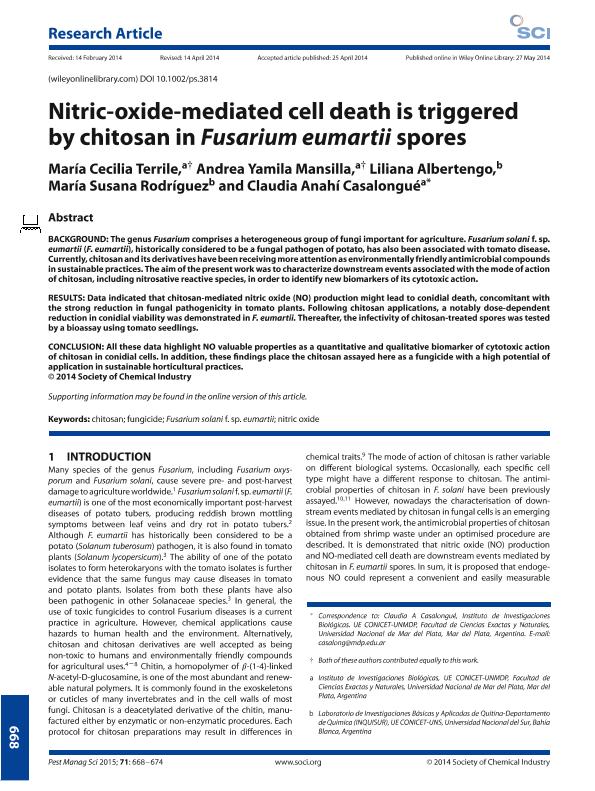Artículo
Nitric-oxide-mediated cell death is triggered by chitosan in Fusarium eumartii spores
Terrile, Maria Cecilia ; Mansilla, Andrea Yamila
; Mansilla, Andrea Yamila ; Albertengo, Liliana; Rodríguez, María Susana; Casalongue, Claudia
; Albertengo, Liliana; Rodríguez, María Susana; Casalongue, Claudia
 ; Mansilla, Andrea Yamila
; Mansilla, Andrea Yamila ; Albertengo, Liliana; Rodríguez, María Susana; Casalongue, Claudia
; Albertengo, Liliana; Rodríguez, María Susana; Casalongue, Claudia
Fecha de publicación:
05/2014
Editorial:
Wiley
Revista:
Pest Management Science
ISSN:
1526-498X
e-ISSN:
1526-4998
Idioma:
Inglés
Tipo de recurso:
Artículo publicado
Clasificación temática:
Resumen
BACKGROUND: The genus Fusarium comprises a heterogeneous group of fungi important for agriculture. Fusarium solani f. sp. eumartii (F. eumartii), historically considered to be a fungal pathogen of potato, has also been associated with tomato disease. Currently, chitosan and its derivatives have been receiving more attention as environmentally friendly antimicrobial compounds in sustainable practices. The aim of the present work was to characterize downstream events associated with the mode of action of chitosan, including nitrosative reactive species, in order to identify new biomarkers of its cytotoxic action. RESULTS: Data indicated that chitosan-mediated nitric oxide (NO) production might lead to conidial death, concomitant with the strong reduction in fungal pathogenicity in tomato plants. Following chitosan applications, a notably dose-dependent reduction in conidial viability was demonstrated in F. eumartii. Thereafter, the infectivity of chitosan-treated spores was tested by a bioassay using tomato seedlings. CONCLUSION: All these data highlight NO valuable properties as a quantitative and qualitative biomarker of cytotoxic action of chitosan in conidial cells. In addition, these findings place the chitosan assayed here as a fungicide with a high potential of application in sustainable horticultural practices.
Palabras clave:
Chitosan
,
Fungicide
,
Fusarium Solani F. Sp. Eumartii
,
Nitric Oxide
Archivos asociados
Licencia
Identificadores
Colecciones
Articulos(IIB)
Articulos de INSTITUTO DE INVESTIGACIONES BIOLOGICAS
Articulos de INSTITUTO DE INVESTIGACIONES BIOLOGICAS
Citación
Terrile, Maria Cecilia; Mansilla, Andrea Yamila; Albertengo, Liliana; Rodríguez, María Susana; Casalongue, Claudia; Nitric-oxide-mediated cell death is triggered by chitosan in Fusarium eumartii spores; Wiley; Pest Management Science; 71; 5; 5-2014; 668-674
Compartir
Altmétricas



